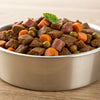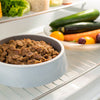How to Transition Your Dog from Wet to Dry Food Smoothly
- Houndsy
Table of Contents
- Introduction
- Understanding the Need for a Transition
- Preparing for the Transition
- Methods for Transitioning from Wet to Dry Food
- Enhancing Acceptance of Dry Food
- Monitoring Your Dog’s Response
- Conclusion
Introduction
Did you know that transitioning your dog from wet to dry food can be a delicate process that, if handled improperly, may lead to gastrointestinal upset? As loving pet owners, we all want to provide our furry companions with the best nutrition possible, but the act of changing their diet can be daunting. In a world overflowing with kibble and canned options, it's essential to choose what's right for our beloved pets.
In this blog post, we will dig deep into the nuances of transitioning your dog from wet to dry food. You’ll learn the best methods to ensure a smooth changeover, keeping your dog's health and comfort front and center. We will explore the reasons behind changing diets, share helpful tips and tricks, and elaborate on why the proper transition matters. By the end of this article, you'll have a comprehensive understand of how to make this dietary shift effective and stress-free for both you and your dog.
As we embark on this journey together, let’s take a moment to reflect on our own feeding routines and consider if they align with what’s best for our furry friends. With the right knowledge in hand, we can elevate every feeding experience, making it a delightful ritual infused with care.
Understanding the Need for a Transition
Why Change Dog Food?
There are various reasons you might find yourself contemplating a switch from wet to dry food. Whether it's to address nutritional deficiencies, cater to health considerations, or simply to offer variety in your dog's meals, it's essential to recognize each situation's specific needs. Common scenarios for making dietary shifts include:
- Health Considerations: Sometimes, a veterinarian will recommend a long-term dietary change to accommodate health issues such as obesity, allergies, or malnutrition.
- Cost Efficiency: Dry food tends to be more budget-friendly compared to wet food, making it an attractive option for cost-conscious pet parents.
- Shelf Stability and Convenience: Dry food has a longer shelf life and is easier to store, making it particularly convenient for busy households.
The Importance of a Gradual Transition
Regardless of the reason for the switch, transitioning too rapidly can lead to digestive distress for your pup. Sudden changes can upset the delicate balance of your dog's gastrointestinal system, potentially leading to discomfort such as vomiting or diarrhea. As thoughtful pet parents, it's crucial to plan a methodical approach to food transitions that promotes health and wellbeing.
Preparing for the Transition
Assessing Your Dog's Current Diet
Before you initiate the transition, take a thorough inventory of your dog's current diet. Consider factors like:
- Ingredients: Examine the nutritional content of both the current wet food and the new dry food. Look for quality protein sources and avoid those with unnecessary fillers.
- Flavor Preferences: Dogs can be picky eaters, so understanding what flavors your dog enjoys can help in selecting an appealing dry alternative.
After evaluating the current food, research similar high-quality dry food options that align with your dog’s nutritional requirements. Look for brands renowned for their commitment to quality, such as those that prioritize natural ingredients and avoid artificial additives.
Choosing the Right Dry Food
As we at Houndsy advocate for dog feeding experiences that elevate and simplify, you’ll want to select dry food that doesn't just meet dietary needs but appeals to your dog's palate. Aspects to consider include:
- Nutritional Requirements: Ensure the new dry food meets your dog's life stage needs (puppy, adult, senior).
- Texture and Size: Dry kibble comes in various sizes and shapes. Choose a kibble that is appropriate for your dog's mouth size and chewing ability to minimize the risk of choking and promote dental health.
Methods for Transitioning from Wet to Dry Food
The Gradual Transition Schedule
Transitioning usually takes about 7-10 days, allowing your dog’s digestive system sufficient time to adapt. A simple yet effective schedule looks like this:
- Day 1-2: 75% old food / 25% new food
- Day 3-4: 50% old food / 50% new food
- Day 5-6: 25% old food / 75% new food
- Day 7: 100% new food
By sticking to this structured approach, we can help ensure a smoother transition while minimizing the risk of gastrointestinal upset.
Adjusting the Pace
Every dog is unique, and some may require a slower transition, especially if they have a sensitive stomach or have not switched foods in a long time. Don't hesitate to prolong each stage, adjusting as needed based on your pet's comfort levels and reactions.
Enhancing Acceptance of Dry Food
Flavor Boosters
During the transition, you might find that your pup shows some reluctance in adapting to the new texture or taste of dry food. To enhance their eating experience, consider these tips:
- Warm the Kibble: Slightly warming dry food with water can release enticing aromas and improve the food’s palatability.
- Meal Toppers: Experiment with healthy toppers or mix-ins, such as a little bit of wet food, homemade bone broth, or even some of your dog's favorite treats, to encourage more enthusiasm for their new meals.
The Importance of Behavior Modification
As we embark on the transition, it’s essential to reinforce positive eating behaviors. For instance, set fixed meal times rather than leaving food out all day to encourage a healthy appetite and prevent free-feeding habits that might hinder the transition.
Monitoring Your Dog’s Response
Once the transition begins, it's important to closely monitor your dog's reactions. Look for signals related to their overall health and wellbeing, such as changes in:
- Appetite: Is your dog excited to eat, and is there a noticeable interest in their food?
- Stool Quality: Changes in bowel movements can indicate how well your dog’s digestive system is adjusting to the new diet.
- Energy Levels: A shift in energy or demeanor can provide insights into whether the new food is well-received.
Should your dog exhibit any concerning symptoms like lethargy, vomiting, or persistent diarrhea, we recommend reverting to the previous wet food and consulting with your veterinarian for advice.
Conclusion
Successfully transitioning your dog from wet to dry food not only elevates their feeding experience but also contributes to their overall health. It’s adaptable, financially savvy, and often more convenient for daily life. By following our structured approach and incorporating strategies to make the transition as seamless as possible, you can ensure your furry friend is receiving the nutrition they need while enjoying their meals.
As we champion the mission of simplifying and beautifying feeding routines, we encourage you to check out our Houndsy Kibble Dispenser – an elegant and practical solution for organizing your dog’s dry food. With convenient portion control and stylish design, it’s perfect for any modern pet owner who values form and functionality.
Regardless of the path you choose, remember that every dog thrives on love, patience, and the best nutritional practices. Transitioning to a different diet is just one way of showing our affection for our cherished furry companions.
FAQ
How long should I take to transition my dog to dry food?
For the best results, we recommend a gradual transition over 7-10 days. Monitor your dog's response and adapt the schedule to their comfort level, extending the transition if necessary.
What if my dog refuses to eat the dry food?
If your dog is hesitant to try dry food, consider mixing in a small amount of wet food or adding warm water to enhance the aroma. You can also try offering the new food at fixed meal times to encourage a healthier eating routine.
Can my dog have both wet and dry food?
Yes! Some pet parents choose to incorporate both wet and dry food into their dog's diet. This can provide additional nutrition and variety, as long as the overall calorie intake is monitored and doesn't exceed daily requirements.
Is it normal for my dog to have an upset stomach during the transition?
Some dogs may experience mild gastrointestinal upset as they adjust to a new diet. If symptoms persist or worsen, it’s advisable to revert to the old food and consult your veterinarian for guidance.
What should I do if my dog has severe digestive issues after switching food?
If your dog experiences severe vomiting or diarrhea, cease feeding the new food and contact your veterinarian immediately to determine whether there are any underlying concerns that need to be addressed.













